MXA MOTOCROSS RACE TEST: 2018 SUZUKI RM-Z450
Q: FIRST AND FOREMOST, IS THE 2018 SUZUKI RM-Z450 BETTER THAN THE 2017 RM-Z450?
A: No. This is a complicated question to answer, because some aspects of the 2018 RM-Z450 are better and some are worse, but overall, this is a bike with issues. The 2018 RM-Z450 is a major revision over the bike that Suzuki has been Band-Aiding for many years. The paradox is that Suzuki has had more time to think about what they would do when they finally did it than almost any motocross manufacturer in history—and what they did wasn’t worth the wait. Oh, don’t get us wrong, the 2018 RM-Z450 is still a valid choice for Suzuki loyalists. It’s just not all that much better than the 2017 model—and in a lot of ways it’s worse.
Q: IS THAT TOO HARSH AN ASSESSMENT?
A: Not when your hard-earned money can buy 2018 bikes that have better suspension, better handling, better brakes, better power, better balance and better clutches—and some that are almost 20 pounds lighter to boot. What the 2018 Suzuki does better than any other bike is turn corners. At turn-in, there isn’t a bike on the track that can carve as tightly as a Suzuki. Cornering is its one superlative. Don’t think that we are saying that the 2018 Suzuki RM-Z450 is the “best handling” bike on the track. It’s not. Far from it. It is just the best turning bike—after the turn, it’s a hot mess.
But, rather than go into a lengthy dissertation on the overall feel of the 2018 Suzuki RM-Z450, it would be much more telling to cover all the aspects separately so that it will make more sense when we put the pieces together.
Q: HOW DOES THE 2018 SUZUKI RM-Z450 RUN?
A: The MXA test riders like the RM-Z450 powerband. It has almost perfect power placement for the average rider. It’s not too hot; it’s not too cold—no, wait, that’s porridge. Let’s start over. It’s not too fast. It’s not too slow. It’s just right for a rider looking for a manageable, no-drama, 450cc motocross powerband. It picks up briskly off the bottom and has excellent hook-up from low to mid. There is better over-rev on top than 2017, but by no means is this a top-end powerband.
Suzuki made major changes to the 2018 engine. The revised cylinder-head port shape increased “tumble flow” by 25 percent. The injector nozzle now mimics KTM’s low-in-the-venturi position. Fuel-pump pressure has been increased for quicker throttle response. The piston has been beefed up with a reinforcing rib. The air filter mounts to a large orifice. The air boot between the air filter and throttle body has been straightened. The intake cam has more lift.
What is the result of all of these modifications? Not much. If you liked last year’s Suzuki engine, you will like this one also. The 2018 engine traces the exact same arc on the dyno chart as the 2017 RM-Z450 did. It makes 1 horsepower more at the 55.16 horsepower peak than last year, but only for a 500-rpm gap. Peak horsepower is at 9000 rpm. It revs to 11,000 rpm, but is flat on top. The Suzuki RM-Z450 makes the least horsepower of any 2018 bike—in some cases as much as 3 horses less.
You may be surprised, given the engine mods, that the 2018 RM-Z450 engine didn’t make more horsepower. But we aren’t surprised. Why? Because in 2016, Suzuki made massive changes to the RM-Z250 engine (i.e., pipe, cams, rod, crank, valves, buckets, wrist pin, mapping, piston and magneto inertia) and didn’t gain any power over the previous 2014–2015 engines.
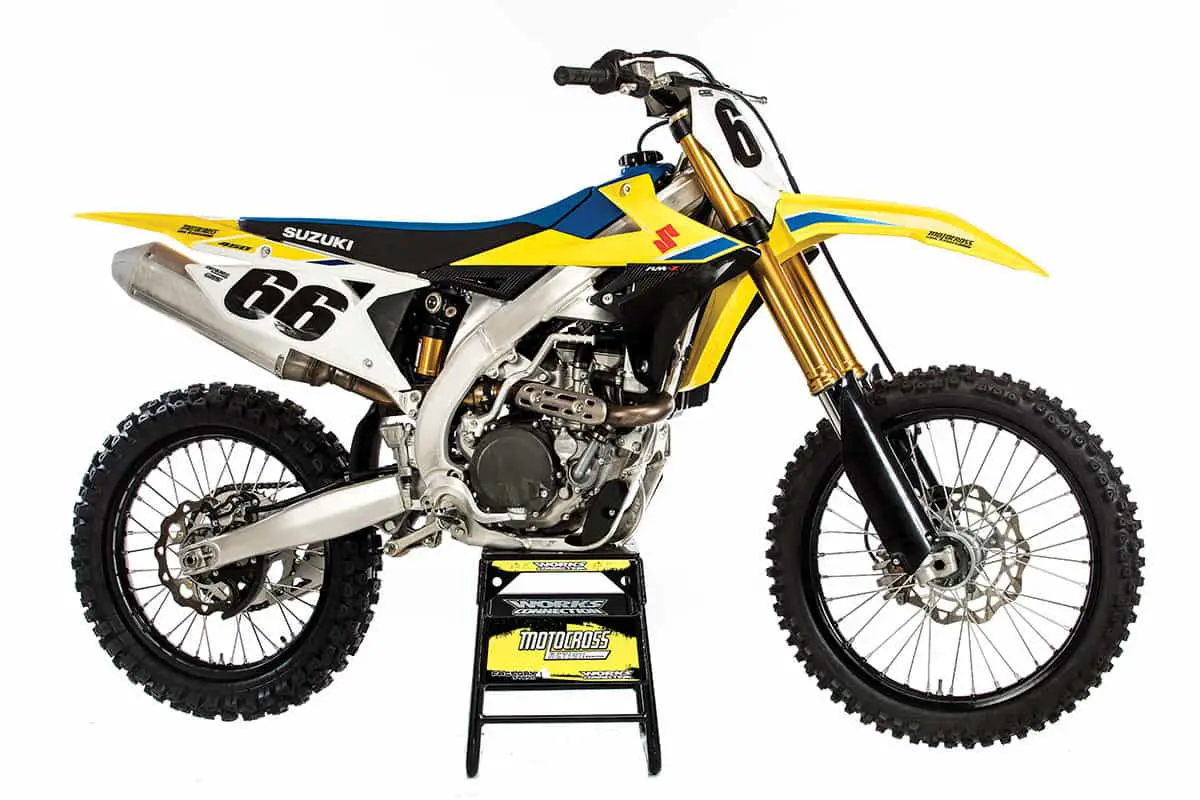 It’s been a long time since Suzuki came out with a totally fresh new RM-Z450. Although lots of parts, sensations and traits remain the same, the 2018 RM-Z450 should reignite the RM-Z450’s flame.
It’s been a long time since Suzuki came out with a totally fresh new RM-Z450. Although lots of parts, sensations and traits remain the same, the 2018 RM-Z450 should reignite the RM-Z450’s flame.
Q: HOW GOOD IS THE 2018 SUZUKI RM-Z450 CHASSIS?
A: This is the most out-of-balance motocross chassis on the showroom floor. It has a stinkbug rear end that leaves the rider looking down the barrel of the handlebars. It is so tall in the rear that it overpowers the front to the extent that it makes the good-turning Suzuki into a bad-turning Suzuki thanks to excessive oversteer. To get the rear end down and the head angle back where it should be, you have to resort to excess race sag. We started at 105mm but still couldn’t find the sweet spot between the front and rear of the RM-Z450. So, we did what any red-blooded American racer would do—we went lower. We went as far as 115mm of sag before we came to our senses. It was true that the lower we went, the better the balance of the chassis felt, but that cannot be said for the rest of the bike. Dropping the sag to get the rear of the bike down ate up shock shaft travel and choppered out the forks so that they felt stiffer in the chop than they were with the rear end sky high. So, we did what any red-blooded American racer would do—and we undid the changes and went back to 105mm of sag.
What was the solution? We ran a longer shock linkage than the stock 135mm link. That lowered the rear of the Suzuki and stiffened up the initial part of the shock stroke, which allowed us to have more options in compression, rebound fork height and head angle settings,. The problem? No one made a shock linkage for the 2018 Suzuki RM-Z450 at the time (now they do). We sweet-talked Pro Circuit’s Bones Bacon into making us two prototype links—136mm and 136.5mm. We spent a full day testing the two links, first to identify which length we preferred and second to find the proper bike setup for the 136mm link we chose.
We can’t tell you what to do to your bike, but you are going to chase your tail until you find the proper balance between the front and rear of the 2018 Suzuki RM-Z450. The frame seems very stiff, and until you get the bike flatter and more resilient, all the work will be done by suspension units that aren’t up to the job. We suggest that you order the longer Pro Circuit link.
Q: HOW GOOD ARE THE NEW COIL-SPRING SHOWA FORKS?
A: Without a doubt, the 2017 coil-spring forks are better than last year’s Showa SFF-TAC air forks, of which we said, “Not a single MXA test rider would volunteer to race the 2017 Suzuki on a rough track, claiming that the forks were valved by incubus.” Suzuki’s 2017 air forks worked about as well as two 49mm pine logs stuck in the triple clamps. Thus, it was a given that if the 2018 forks moved, they would be considered an improvement.
They are much better than what came before, but they aren’t great forks. They exhibit the same sensation that the Showa coil-spring forks on the 2018 Honda CRF450 deliver—harshness at the top of the fork’s stroke followed by a mysterious lack of mid-speed compression damping and hard bottoming. The RM-Z450 and 2018 CRF450 share the same basic fork, but the RM-Z has stiffer compression and faster rebound. The result, on both the CRF450 and RM-Z450, is a fork that chatters in the braking bumps and dives excessively in high-speed hits.
Think about that statement for a second. They are harsh and chattery over small bumps but dive and bottom over big bumps. How would you fix them? Would you stiffen them up to stop the bottoming? Or would you soften them up to take the jackhammer effect out in the small stuff? Quite the quandary. Our solution was the only logical one, short of sending them to your local suspension guru. We raised the oil level in the forks by 10cc. This ramped up the stiffness at the bottom of the stroke to stop the forks from bottoming. Then, we turned the clickers out, although not very far, to soften up the compression damping for the small, mid-sized hits. Not perfect, but much better for something that cost almost nothing but time to do.
Suzuki wanted to enhance the cornering prowess of a bike that didn’t need enhancement. The result is an out-of-balance chassis that oversteers—until you fix it with shock, linkage and setup mods.
Q: HOW GOOD IS THE INNOVATIVE BFRC REAR SHOCK?
A: We love innovation, even innovation that is borrowed from someone else. Thus, we wanted to love the all-new (if you don’t count the Ohlins TTX shock it was borrowed from) twin-tube Showa BFRC rear shock. On a traditional rear shock absorber, a plunger pushes a valve with holes in it down through the oil in the shock body. The holes are covered by thin, circular metal shims of varying thicknesses and diameters. The oil, which is being compressed, has to bend the shims out of the way to get to the other side of the valve. The configuration of shims, on both the compression and rebound sides of the valve, determines how much damping the shock has. Since the plunger strokes up and down in the shock body, the damping changes with both plunger speed, direction and position. That is how most motocross shocks work. But not the BFRC.
The Balance Free Rear Suspension (BFRC) shock plunger doesn’t have a valve with shims on it. It is just a plunger, nothing more. It cycles the shock oil out of the main shock body tube into a secondary tube that brings the displaced oil up to the cavity where the clicker adjuster is located. The clickers share this space with the compression and rebound shim stacks that are no longer in the shock body. Taking the shim stacks off the plunger reduces the cavitation that comes from the oil sloshing around, and the two types of damping can be better controlled.
It sounds good, but it is not ready for prime time. The problem is that Suzuki’s BFRC shock isn’t well damped. Its shim stacks are not properly configured. It moves too freely, and harnessing the loose feeling uses up most of the available clicker settings (noting that the clickers on the BFRC shock do not click). The BFRC got its best results in road racing, which has much different load characteristics from motocross. The result is what test riders referred to as “wobble,” “wallow,” “waggle” and “see-saw”, all referencing the shock’s unwillingness to take a set unless the rear tire was hooked up and driving.
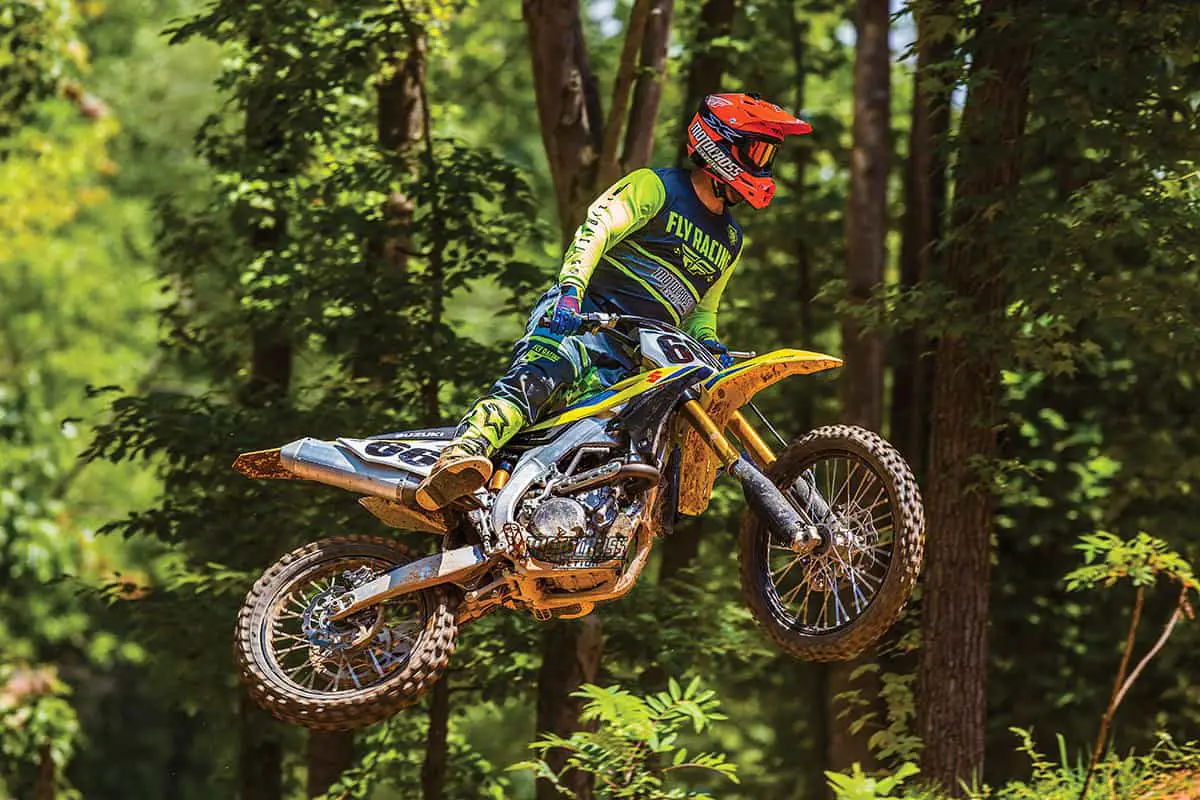 It does not feel light in the air and once in motion the weight does not go away. The RM-Z450 is the heaviest bike on the track. For 2018, the YZ450F, CRF450 and RM-Z450 all gained weight that they could ill-afford to pack on their already obese machines.
It does not feel light in the air and once in motion the weight does not go away. The RM-Z450 is the heaviest bike on the track. For 2018, the YZ450F, CRF450 and RM-Z450 all gained weight that they could ill-afford to pack on their already obese machines.
Q: HOW MUCH DOES THE 2018 SUZUKI RM-Z450 WEIGH?
A: On MXA’s calibrated balance-beam scale, the Suzuki hits 241 pounds. That is 1 pound heavier than it was in 2017. You can feel the weight when you ride the bike. When the RM-Z450 is hooked up and going in a straight line, the weight is not an issue, but leaning into berms, balancing in ruts or getting it stopped makes you work harder than on a lighter bike, not to mention that the added pounds make the brakes, suspension, gearbox and engine work harder also.
The strange thing about the 2018 motocross bikes is that the Honda CRF450, Yamaha YZ450F and RM-Z450 all got heavier. Part of the weight gain is caused by the switch to coil-spring forks, which weigh 3 pounds more than the air forks that Suzuki used last year, and—in the case of the 2018 YZ450F and CRF450—the addition of electric starting added at least 5 more pounds. At 241 pounds, the RM-Z450 is the heaviest of the Japanese-made bikes. The Honda is second heaviest at 240 pounds, with weight gained by adding electric start and heavier fork and shock springs for 2018. The Yamaha YZ450F is the third heaviest at 239 pounds, which is 1 pound heavier than it was in 2017. The Kawasaki KX450F weighed 231 pounds in 2017 and still weighs 231 pounds in 2018.
The “Big Four” Japanese brands seem to be living in a bubble where they believe they are only in competition with one another and not with KTM and Husqvarna. They may be able to justify the porcine nature of their 2018 bikes by comparing them to the other Japanese manufacturers’ offerings, but the 2018 Suzuki RM-Z450 weighs 19 pounds more than the 2018 KTM 450SXF. There isn’t enough titanium in the world to get an RM-Z close to a 450SXF.
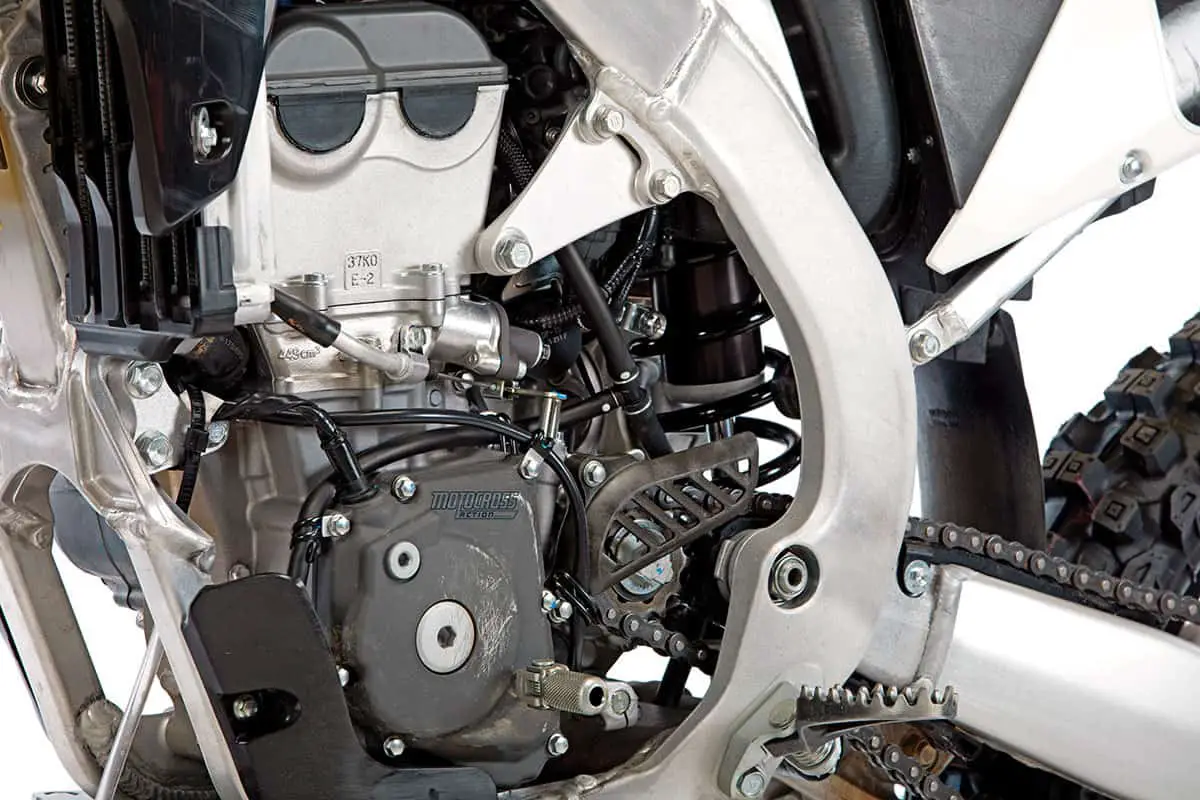 Suzuki got the least bang for their buck out of the engine mods that they made to the 2018 RM-Z450.
Suzuki got the least bang for their buck out of the engine mods that they made to the 2018 RM-Z450.
Q: WHAT ARE THE BEST ATTRIBUTES OF THE 2018 SUZUKI RM-Z450?
A: Although the MXA test riders had some issues with the setup of the 2018 Suzuki RM-Z450, there were lots of things that we liked about the bike.
Powerband. Every test rider loved the powerband. It picks up cleanly off the bottom and gets its job done in the rpm range where the typical rider likes his power. While it’s not as fast as the green, red, blue, white or orange bikes, it has charms that you will only notice in the middle of a race when under intense pressure.
Tuneablity. The 2018 RM-Z comes with three plug-in maps: stock (white), aggressive (white with two wires sticking out) and mellow (grey). Most test riders preferred the stock plug-in for general racing. The aggressive map perked up the throttle response but was a little lean on the top end; however, it would be okay on jump tracks.
Cornering. We wouldn’t go so far as to say that the 2018 RM-Z450 is the best-handling bike of 2018, because it isn’t. The Suzuki RM-Z450 has-a-turn-at-all-costs philosophy, and turns are where it excels. When you aren’t turning corners, the Suzuki is twitchy, loose and, in short, a handful. It is best suited to smooth tracks and Supercross jumps.
Ergos. The bodywork is narrower. The bar bend is more comfortable, and everything falls at hand easily. The stinkbug chassis takes away from all of the good things, so that is job number one on the modification plan.
 The stinkbug rear end was a problem. To alleviate the chassis issues, we drop-kicked the stock 135mm linkage.
The stinkbug rear end was a problem. To alleviate the chassis issues, we drop-kicked the stock 135mm linkage.
Q: WHAT DID WE HATE?
A: The hate list:
(1) Clutch. This isn’t a clutch. The RM-Z clutch is a mechanical device that shaves down fiber plates. None of the Japanese clutches are as good as the hydraulic clutches on the KTM, Husqvarna and TM. If you can’t afford a Hinson clutch for your RM-Z450, invest in stiffer clutch springs.
(2) Weight. You always hear pundits say that you don’t need a lighter bike, you just need to go on a diet and lose 20 pounds. That would be great, especially if you did that on a KTM, the overall weight would be almost 40 pounds lighter than on the 2018 RM-Z450.
(3) Brakes. Suzuki finally joined the 270mm rotor brigade, but that just means that the Suzuki now has the weakest brakes of those bikes with 270mm rotors. The KTM and Husqvarna have 260mm rotors and much better stoppers.
Q: WHAT DID WE LIKE?
A: The like list:
(1) Handling. Once you work out the balance issues, there isn’t a bike on the track that can turn as sharply as the RM-Z450. Conversely, there isn’t a bike on the track that is as skittish in a straight line.
(2) Power. The 2018 RM-Z450 has a well-placed powerband. It doesn’t make much in the way of peak horsepower, but the power it makes is incredibly usable.
(3) Tires. Last year the RM-Z450 came with a Bridgestone 403/404 tire combo. We suggested that Suzuki spec a Bridgestone X40 rear with an X30 front in 2018. They didn’t do what we wanted, but they came close by spec’ing an X30 front with an X30 rear. Why did we want the Bridgestone X40 rear instead of the X30? Three reasons: First, the X40 works in a wider range of conditions than the intermediate-to-soft X30. Second, the X40 wears better. Third, the X40 is several pounds lighter than the X30.
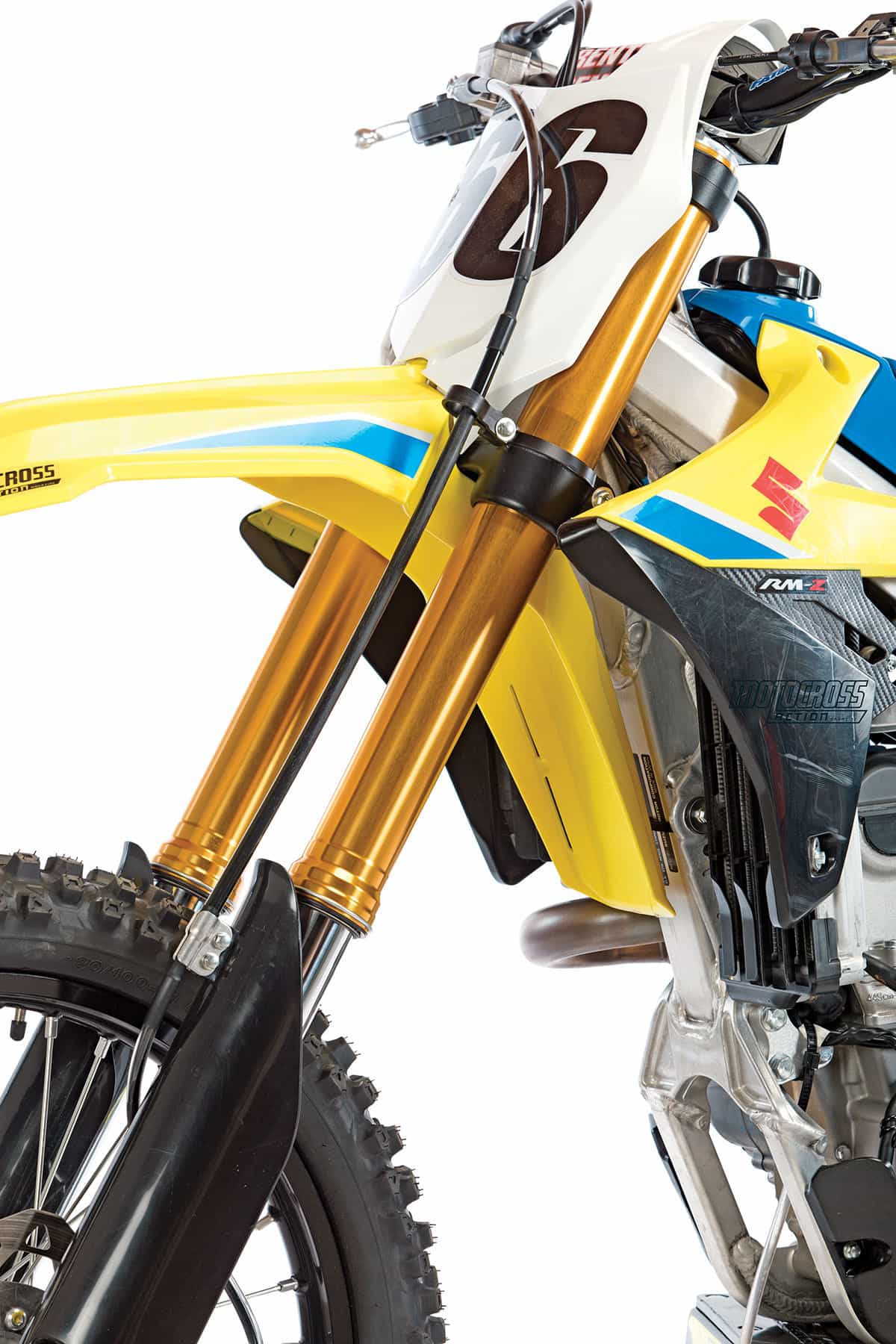 Before the RM-Z450 went to air forks, it had atrocious coil spring forks. The 2018 coil spring forks are a step up.
Before the RM-Z450 went to air forks, it had atrocious coil spring forks. The 2018 coil spring forks are a step up.
Q: WHAT DO WE REALLY THINK?
A: We think that given another year of R&D, Suzuki could have done so much better. Most of the needed fixes could easily be handled on the assembly line and with some real-world testing. If you can’t wait, don’t worry, you can order an exhaust pipe, have the forks re-valved, buy a longer shock linkage and join a gym to get strong enough to lift it onto a bike stand.
MXA’S 2018 SUZUKI RM-Z450 SETUP SPECS
This is how we set up our 2017 Suzuki RM-Z450 for racing. We offer it as a guide to help you get your own bike dialed in.
SHOWA COIL-SPRING FORK SETTINGS
There is nothing magical about the switch from air forks to coil-spring forks. The onus is still on the suspension technicians to get the valving right. Most people are so angry about the complexity of the Showa TAC air forks that they put on rose-colored glasses about how great coil-spring forks were back in the day. Snap out of it.
The last year that Suzuki used coil-spring forks was in 2014. How good were the 2014 RM-Z450 forks? Here is what we said back then: “We dread racing the bike with the stock jackhammer forks. They beat us to death in the bumps because they barely moved in the mid-stroke. The only time that the Showa forks felt good was when we raced the bike on smooth, hard-packed tracks with lots of jumps and very few bumps. In these conditions, the stiff forks came in handy when landing from jumps and didn’t penalize the rider in the nonexistent bumps.” We just point this out to illustrate that the addition of metal coils is not the end-all and be-all solution to front suspension problems. For hardcore racing, these are MXA’s recommended 2018 RM-Z450 fork settings (stock settings are in parentheses):
Spring rate: 0.50 N/m
Compression: 7 clicks out (6 clicks out)
Rebound: 12 clicks out
Fork-leg height: First line (second line)
Notes: We added 10cc of oil to both fork legs to stiffen the forks in the last 4 inches of travel to stop them from bottoming. This gave us more leeway in dialing in the compression. MXA test riders ran the compression from 7 to 12 clicks out, depending on rider speed and track conditions.
SHOWA BFRC SHOCK SETTINGS
We loved last year’s traditional shock absorber—and we wish that Suzuki’s product managers had not decided to take a chance on the unusual BFRC shock. Consumers shouldn’t be guinea pigs for a stink-bug rear end and a loose-feeling shock setup. It should be noted that the compression and rebound are adjusted by counting turns on the bleed screws, not by clicks. The BFRC shock does not have a high-speed compression adjuster. Additionally, there is no rebound adjuster under the shock. Both compression and rebound adjusters are mounted on the piggyback and labeled “Ten” for rebound and “Com” for compression. For hardcore racing, these are MXA’s recommended 2018 Suzuki RM-Z450 shock settings (stock settings are in parentheses).
Spring rate: 56 N/m
Hi-compression: NA
Compression: 1 turn out (1.5 turns out)
Rebound: 1 turn out (3 turns out)
Race sag: 105mm (108mm)
Notes: We hated the high-in-the-rear layout of the 2018 RM-Z450. We tried lowering it with extra race sag, but it made both ends harsher. We eventually ran a 1mm-longer shock linkage, which lowered the rear of the bike and stiffened the initial shock damping. We recommend the link.
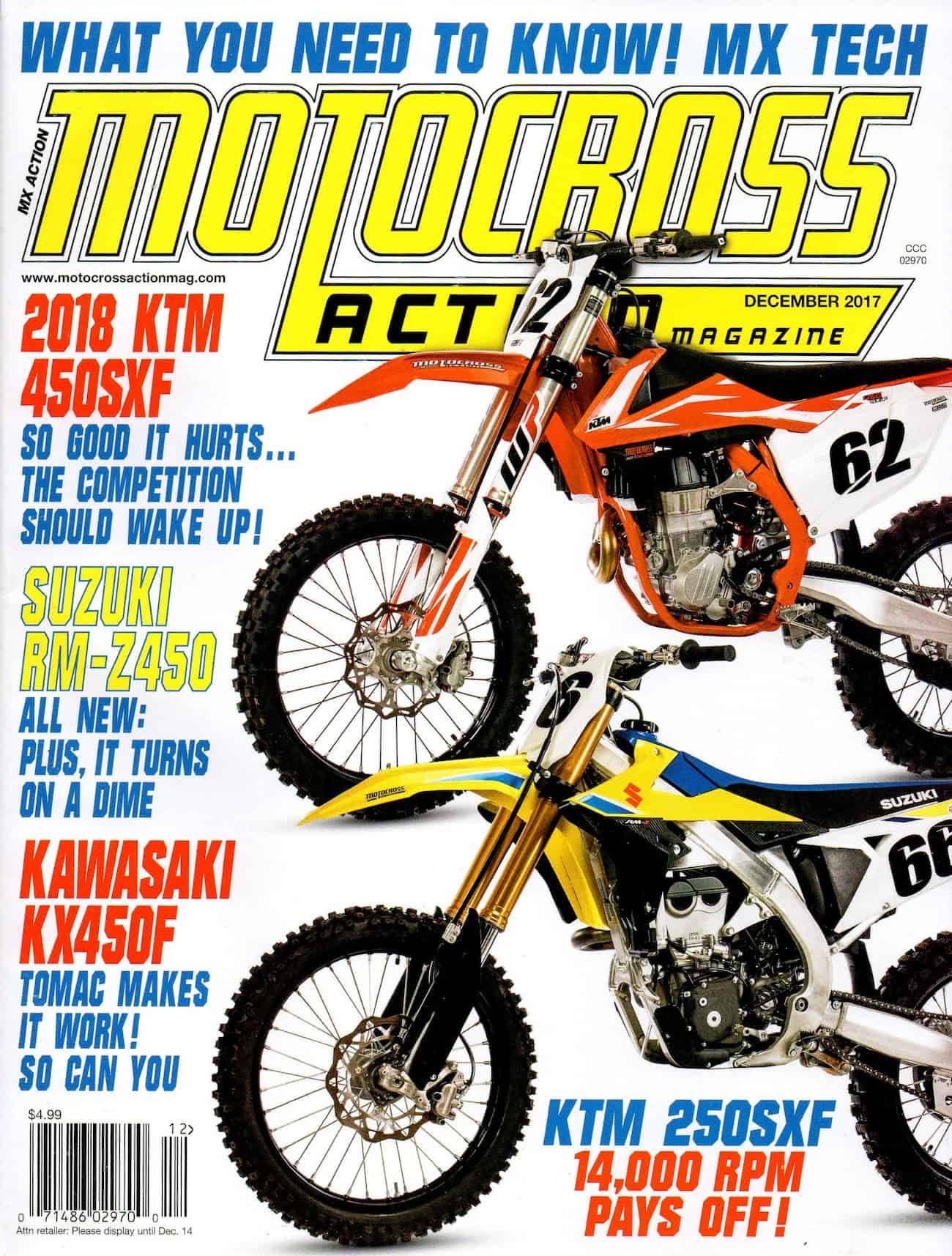 Had you subscribed to MXA, you would have read this complete bike test when in came out back in November. Click the box below to subscribe.
Had you subscribed to MXA, you would have read this complete bike test when in came out back in November. Click the box below to subscribe.


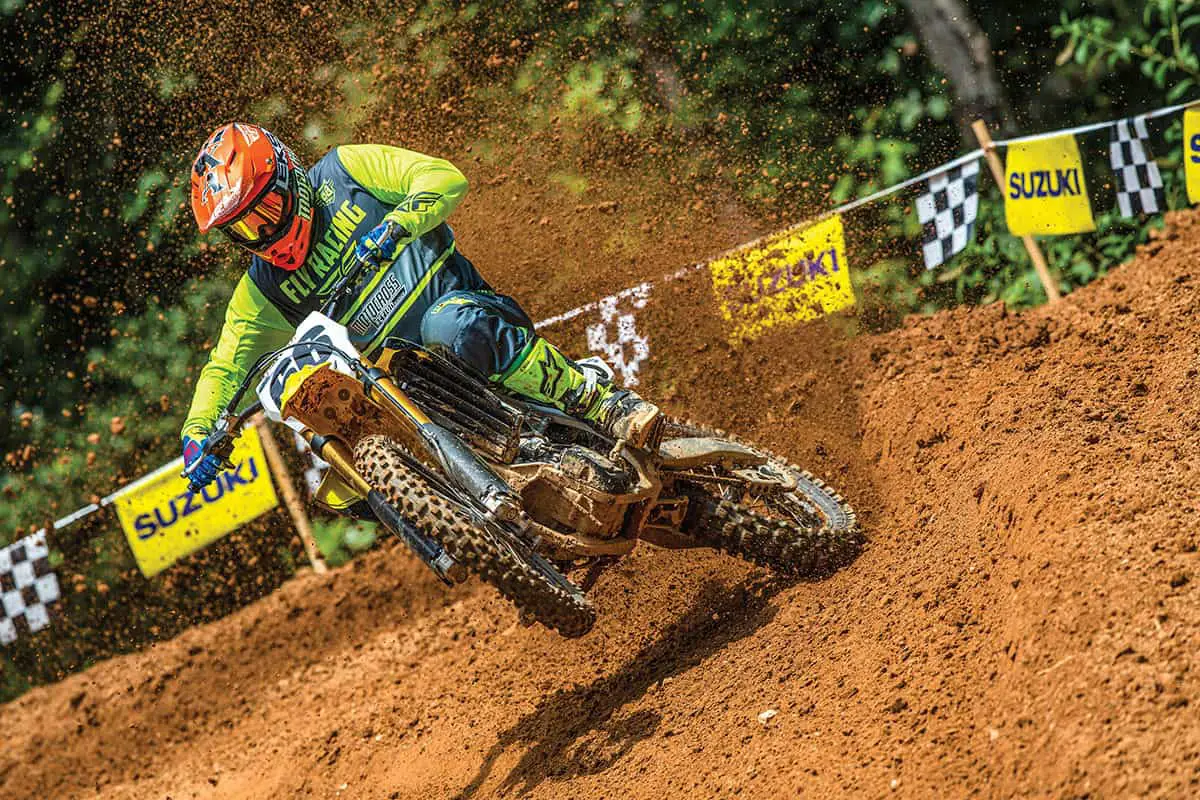





Comments are closed.